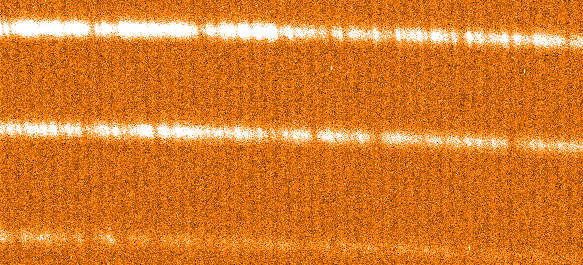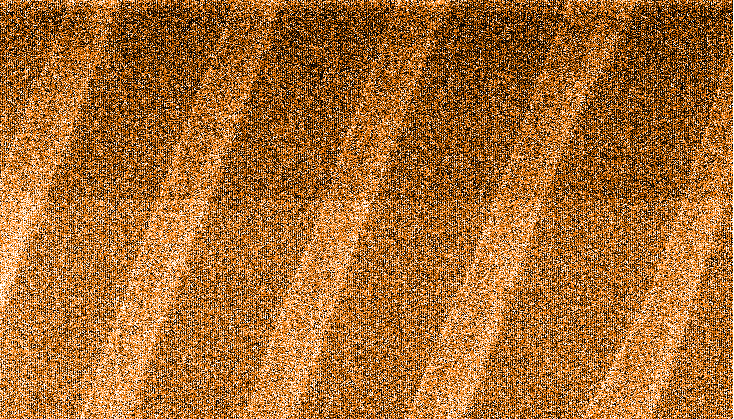 mirror sites:
PL (internal link)
HQ
[?]
mirror sites:
PL (internal link)
HQ
[?]
Quality Control and
Data Processing
|
XSHOOTER: Bias
Bias frames are acquired for the UVB-arm and VIS-arm optical CCD science detectors only. The pipeline processes five raw frames into a master bias. Bias frames come in low gain and high gain read mode and three different types of binning: 1x1, 1x2 and 2x2.  Bias level
Bias level
The median of the master bias is trended for two arms:
UVB
and
VIS,
two read-out modi (clocking): 100k/1p/hg and 400k/1p/lg and two types of binning:
1x1, 1x2. The bias level is stable at a level of around 1000 ADU (UVB and VIS, 1500 ADU for the AGC) with +-0.5 ADU fluctuations. The thresholds are at +-2% of the long-term mean.
A median stacking method is used to generate a master bias product. The median bias level is the median of the master bias frame.  Readout noise
Readout noise
The read out noise of the master bias is trended for two arms:
UVB
and
VIS,
two read-out modi (clocking): 100k/1p/hg and 400k/1p/lg and three types of binning:
1x1, 1x2 and 2x2. While the read-out noise of the master bias is a property of the calibration product and describes, how good the read noise has been reduced in the product, the read-out noise measured in the raw bias frame describes a detector property.
The read out noise of the raw bias is trended for two arms:
UVB
and
VIS,
two read-out modi (clocking): 100k/1p/hg and 400k/1p/lg and three types of binning:
1x1, 1x2 and 2x2. Scoring&thresholds Readout noise The UVB-arm (raw frame) read out noise is stable at 4 ADU with some sporadic outliers in 2015. The VIS-arm read out noise is less stable and is characterized by more frequent outliers towards larger values. Thresholds are set by statistical and operational meaningful arguments to +-1 ADU.
The first two raw bias frames are subtracted. The median of the statistical noise derived from a random sample of frame sub regions is obtained and divided by sqrt(2).  Structural noise
Structural noise
The large scale gradient of the master bias in x-direction is trended for two arms:
UVB
and
VIS,
two read-out modi (clocking): 100k/1p/hg and 400k/1p/lg and two types of binning:
1x1, 1x2. The gradients of the AGC master bias AGC), is monitored for a unique setup. Scoring&thresholds Structural noise The fluctuations in the AGC x-gradient are related the the ambient temperature. The gradients of the UVB and VIS are stable, thresholds have been set, that the long term average and the typical fluctuations are well within the acceptable region.
struct_x gives the structure along the x-axis for the left (x1) and right (x2) half of the CCD. For that purpose the master bias is averaged along the y-axis and the resulting one-dimensional frame is fit with a linear expression. The slope of that expression is then stored as struct_x1/2.  periodic pattern noise
periodic pattern noise
The qc_PN_maxrat parameter, the maximum among the five product qc_PN_std[i]/qc_PN_stdmad[i] values is monitored.
qc_PN_std[i] is the non-robust standard deviation of the 2D Fourier transform product of raw BIAS frame #i.
qc_PN_stdmad[i] is the robust standard deviation standard estimation via the median absolute deviation method,
of the 2D Fourier transform product of raw BIAS frame #i.
The qc_PN_maxrat is trended for two arms:
UVB
and
VIS,
two read-out modi (clocking): 100k/1p/hg and 400k/1p/lg and three types of binning:
1x1, 1x2 and 2x2. Scoring&thresholds periodic pattern noise
Algorithm periodic pattern noise Each raw frame is 2D Fourier transformed. A mask is used to filter out the pixel-to-pixel frequency. |
||||||||||||||||||||||||||||||||||||||||||||||||||||||||||||||||||||||||||||||||||||||||||||||||||||||||||||||||||||||||||||||||||||||||||||||||||||||||||||||||||||||||||||||||||||||||||||||||||||||||||||||||||||||||||||||||||||||||||||||||||||||||||||||||||||||||||||||||||||||||||||||||||||||||||||||||||||||||||||||||||||||||||||||||||||||||||||||||||||||||||||||||||||||||||||||||||||||||||||||||||||||||||||||||||||||||||||||||||||||||||||||||||||||||||||||||||||||||||||||||||||||||||||||||||||||||||||||||||||||||||||||||||||||||||||||||||||||||||||||||||||||||||||||||||||||||||||||||||||||||||||||||||||||||||||||||||||||||||||||||||||||||||||||||||||||||||||||||||||||||||||||||||||||||||||
| |
|||||||||||||||||||||||||||||||||||||||||||||||||||||||||||||||||||||||||||||||||||||||||||||||||||||||||||||||||||||||||||||||||||||||||||||||||||||||||||||||||||||||||||||||||||||||||||||||||||||||||||||||||||||||||||||||||||||||||||||||||||||||||||||||||||||||||||||||||||||||||||||||||||||||||||||||||||||||||||||||||||||||||||||||||||||||||||||||||||||||||||||||||||||||||||||||||||||||||||||||||||||||||||||||||||||||||||||||||||||||||||||||||||||||||||||||||||||||||||||||||||||||||||||||||||||||||||||||||||||||||||||||||||||||||||||||||||||||||||||||||||||||||||||||||||||||||||||||||||||||||||||||||||||||||||||||||||||||||||||||||||||||||||||||||||||||||||||||||||||||||||||||||||||||||||||
 |
|
||||||||||||||||||||||||||||||||||||||||||||||||||||||||||||||||||||||||||||||||||||||||||||||||||||||||||||||||||||||||||||||||||||||||||||||||||||||||||||||||||||||||||||||||||||||||||||||||||||||||||||||||||||||||||||||||||||||||||||||||||||||||||||||||||||||||||||||||||||||||||||||||||||||||||||||||||||||||||||||||||||||||||||||||||||||||||||||||||||||||||||||||||||||||||||||||||||||||||||||||||||||||||||||||||||||||||||||||||||||||||||||||||||||||||||||||||||||||||||||||||||||||||||||||||||||||||||||||||||||||||||||||||||||||||||||||||||||||||||||||||||||||||||||||||||||||||||||||||||||||||||||||||||||||||||||||||||||||||||||||||||||||||||||||||||||||||||||||||||||||||||||||||||||||||||


